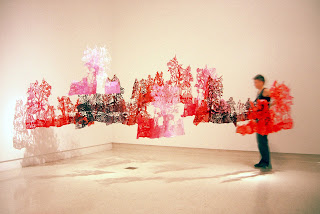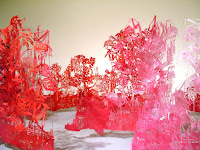 |
| Incessant pruning generates prickly fruit, hand cut paper, ink, Perspex rods 2004 |
This paper-cut tree appears to be more of a stump, over worked, and fragile, almost lifeless. Beside the tree are two “fruits” made from the knife blades that have been inserted and stitched into a paper-cut sphere.
 |
| Prickly fruit blades and paper |
The
imagery relates to the development of Melbourne as a city. At the
base of the 'tree' a narrative begins with imagery from historical
documents, referencing the Batman Treaty and the and cultivation of
land, subdivision and the construction of the skyscraper and, at it's
outer most limbs, are images of cranes and construction equipment,
suggesting that development will continue.
 |
| Incessant pruning generates prickly fruit, (detail) hand cut paper, ink, Perspex rods 2004 |
Below is a re-hang of the work, configuring a three dimensional object onto
a two dimensional space, offering the viewer a greater appreciation
of the details, therefore allowing a better understanding of the
narrative content.
Exhibited as part of “Urban Jam”, RMIT Project
Space, Carlton, and Switchback Gallery, Morwell. October 2005.
 |
| Incessant pruning generates prickly fruit, hand cut paper, ink, created in 2004 reconfigured in 2005 |








